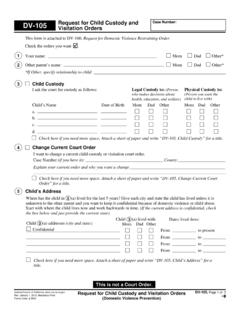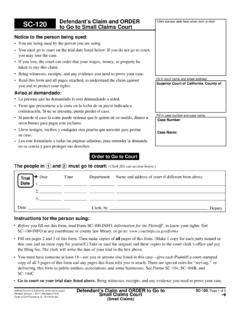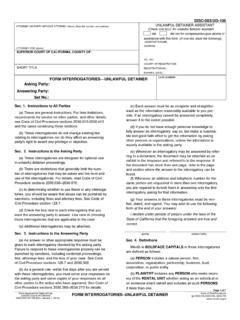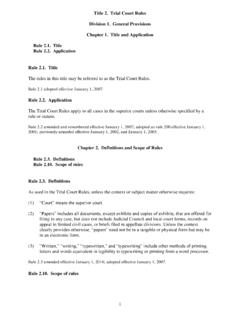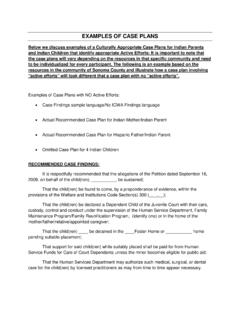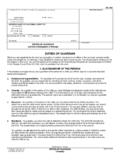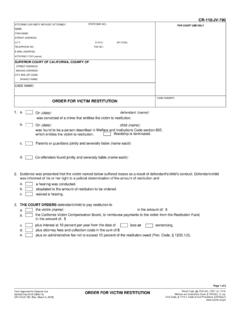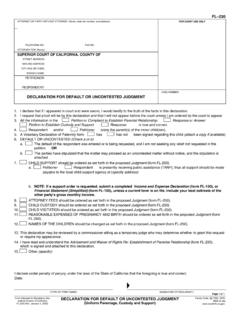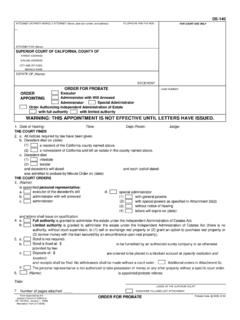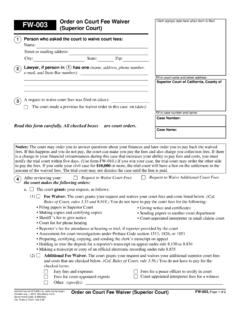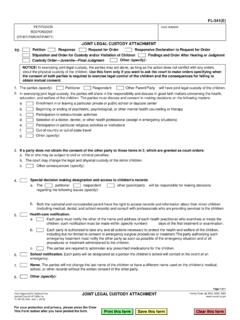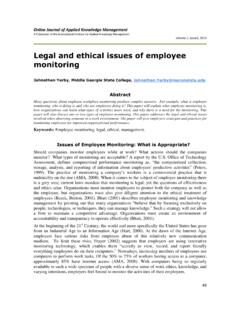Transcription of FL-107-INFO Legal Steps for a Divorce or Legal Separation
1 Legal Steps for a Divorce or Legal Separation FL-107-INFOJ udicial Council of California, Revise January 1, 2015, Optional Form Cal. Rules of Court, rule Steps for a Divorce or Legal SeparationFL-107- info , Page 1 of 2 IMPORTANT NOTICESThe earliest you can be divorced is six months and one day from one of these three dates (whichever occurs first): (1) the date Respondent was served with the Summons (form FL-110) and Petition (form FL-100), (2) the date the Response (form FL-120) was filed, or (3) the date Appearance, Stipulations, and Waivers (form FL-130) was filed. Legal Separation has no waiting period. You are NOT divorced or legally separated until the court enters a Judgment inyour you need court orders for child support, custody, parenting time (visitation), spousal or partner support, restraining orders, or other issues, file a Request for Order (form FL-300) asking for temporary orders.
2 See Request for Order Information at for more 1. Start Your Case The forms needed to start your case and information about filing fees and fee waivers are available at Filing Your Case, at The petitioner (the person who files the first Divorce or Legal Separation forms with the court) fills out and files with the court clerk at least a Petition Marriage/Domestic Partnership (form FL-100) and a Summons (form FL-110) and, if there are children of the relationship, a Declaration Under Uniform Child Custody Jurisdiction and Enforcement Act (form FL-105). The court clerk will stamp and return copies of the filed forms to the respondent has 30 days to file and serve a Response. So, the petitioner must wait 30 days before starting Step 4.
3 Someone 18 or older not the petitioner serves the spouse or domestic partner (called the respondent) with all the forms fromStep 1 plus a blank Response Marriage/Domestic Partnership (form FL-120) and files with the court a proof-of-service form, such as Proof of Service of Summons (form FL-115), telling when and how the respondent was served. (To serve means to givein the proper Legal way. ) For more information, see Serving Your First Set of Court Forms at STEP 2. Serve the FormsRespondent files a ResponseRespondent does not file a Response (called default ) No Response and NO written agreement: Petitioner waits 30 days after Step 2 is complete and prepares a proposed Judgment (form FL-180), together with all other needed forms.
4 See True Default Case at No Response BUT written agreement: Petitioner attachesthe signed and notarized agreement to the proposed Judgment (form FL-180), together with all other needed forms. See Default Case with Written Agreement at AND written agreement: Either party files Appearance, Stipulations, and Waivers (form FL-130) and the proposed Judgment with written agreement attached and other needed forms. See Uncontested Case at and NO agreement: Parties must go to trial to have a judge resolve the issues. See Contested Case at STEP 4. Finish the Divorce or Legal Separation Case in One of Four WaysYou must keep the court and the other party informed of any change in your mailing address or other contact information.
5 File and serve a Notice of Change of Address or Other Contact Information (form MC-040) on the other party or his or her attorney to let them know about the change in your contact the same time as Step 1 or within 60 days of filing the Petition, the petitioner must fill out and have these documents served on the respondent: Declaration of Disclosure (form FL-140), Income and Expense Declaration (form FL-150), Schedule of Assets and Debts (form FL-142) or Property Declaration (form FL-160), and all tax returns filed by the party in the two years before serving the disclosure documents. These disclosure documents are not filed with the court. If the respondent files a Response, he or she must also complete and serve the same disclosure documents on the petitioner within 60 days of filing the Response.
6 The 60-day time frame for serving the disclosures may be changed by written agreement between the parties or by court petitioner and respondent each file a Declaration Regarding Service (form FL-141) with the court saying disclosures were served. If the respondent does not serve disclosures, the petitioner can still finish the case without them. For more information, see Fill Out and Serve Your Financial Declaration of Disclosure Forms at (click on Step 4). STEP 3. Disclose Financial Information Annulments: See for information about January 1, 2015FL-107- info , Page 2 of 2 Legal Steps for a Divorce or Legal SeparationYou may prefer to resolve some or all of the issues in your Divorce or Legal Separation case without having the court decide for you.
7 You and your spouse or domestic partner can put your agreement in writing and file it in your case. But your agreement must follow all Legal requirements. Getting help to resolve Divorce or Legal Separation casesDo you have a registered domestic partnership? The process for a Divorce or Legal Separation of a domestic partnershipis the same as on page 1. For information about ending your domestic partnership in the superior court, see To find out if you are eligible to end your domestic partnership through the Secretary of State, see Note: There may be differences in federal taxes and other issues for domestic partnerships. Seek advice from an attorney experienced in domestic partner if you want a Legal Separation ?
8 The process on page 1 is the same, except you will NOT get a Judgment for Legal Separation unless both parties agree to a Legal Separation OR if respondent has not filed a Response. If both parties agree to be legally separated but do not agree on other issues, the parties must go to trial to have a judge resolve those issues. You are NOT legally separated until you receive a Judgment signed by the court. For more information, see Legal Separation at AFTER the court enters a judgment for Legal Separation , if you decide you want a Divorce , you must start a new case to request a Divorce and pay another filing fee. Legal Steps for a Divorce or Legal Separation FL-107-INFOF amily Law Facilitators and Self-Help Centers help with court forms and instructions.
9 They can provide samples of agreements and other information and, in some cases, help with information sheet gives you only basic information on the Divorce or Legal Separation and is not Legal advice. If you want Legal advice, ask a lawyer for help. You may also:Contact the family law facilitator or self-help center in your court for information, court forms, and referrals to local Legal resources. For more information, see if there is domestic violence? Private services (which you can hire to help you resolve your case):Where can I get help?Lawyers. Also called attorneys, lawyers can help work out agreements between the parties and represent you at court hearings and A lawyer or counselor who helps the parties communicate to explore options and reach a mutually acceptable Lawyers.
10 Lawyers who represent each party but do not go to court. They try to reach an agreement. If court is necessary, the parties must hire new Conferences. An informal process in which a judge or an experienced lawyer meets with the parties and their lawyers to discuss the case and their positions and suggests a resolution. The parties can either agree to the suggestions or use the suggestions to help in further settlement Court Services. If you and the other parent already have a family law case and have filed a Request for Order (form FL-300) seeking orders about child custody and visitation (parenting time), the court will refer you to Family Court Services. They provide child custody mediation or child custody recommending counseling to try to help you both make a parenting plan that is in the best interest of your child.
